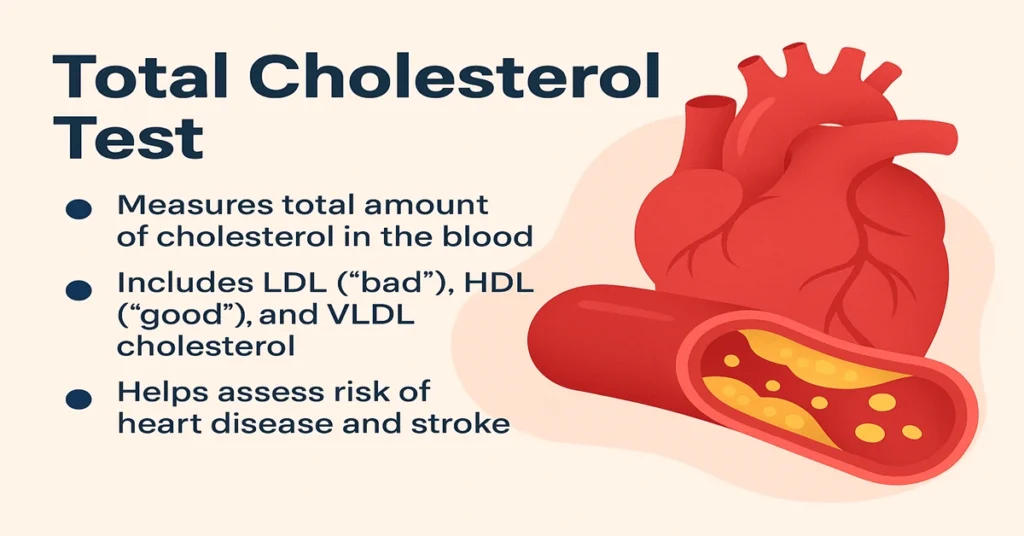Introduction
Cholesterol is a type of fat (lipid) that plays a vital role in the human body. While it often gets labeled as “bad,” the truth is that cholesterol is essential for life. The problem arises when levels become too high or too low, creating risks for heart disease, stroke, and other health issues.
The Total Cholesterol (TC) Test measures the overall cholesterol in your blood. It includes all cholesterol particles, such as:
- LDL (Low-Density Lipoprotein) – often called “bad” cholesterol because high levels can clog arteries.
- HDL (High-Density Lipoprotein) – considered “good” cholesterol as it removes excess cholesterol from blood vessels.
- VLDL (Very-Low-Density Lipoprotein) and other lipid particles.
This test is usually performed as part of a lipid profile and helps evaluate your risk of cardiovascular diseases.
What is Total Cholesterol (TC)?
Total Cholesterol (TC) refers to the sum of all cholesterol carried by LDL, HDL, VLDL, and other lipoproteins. Since cholesterol travels in the blood bound to proteins, measuring TC gives doctors an overview of lipid health and cardiovascular risk.
Where is Cholesterol Produced in the Body?
The human body produces cholesterol naturally and also absorbs it from food.
- Main production site: Liver (about 80% of body cholesterol).
- Other sources: Intestines, adrenal glands, and reproductive organs.
- External intake: Meat, dairy, eggs, fried and processed foods provide dietary cholesterol.
Even though cholesterol from food contributes, the body tightly regulates production, which means lifestyle and genetics play a bigger role in cholesterol balance.
Functions and Importance of Cholesterol
Cholesterol is not just “fat in the blood” – it has many vital functions:
- Building cell membranes – essential for cell structure.
- Making hormones – including estrogen, testosterone, progesterone, and cortisol.
- Vitamin D production – necessary for strong bones and immunity.
- Formation of bile acids – helps digest fats and absorb fat-soluble vitamins (A, D, E, K).
Cholesterol is vital for life, but balance is the key. Too much or too little cholesterol can both be harmful.
Causes of Low Total Cholesterol (Hypocholesterolemia)
Low cholesterol is less common but can occur in certain conditions:
- Malnutrition or starvation.
- Hyperthyroidism (overactive thyroid).
- Liver disease (poor production).
- Certain cancers.
- Chronic infections (like tuberculosis).
- Inherited lipid disorders.
- Use of cholesterol-lowering drugs such as statins.
Symptoms of Low Cholesterol
Low cholesterol usually does not cause obvious symptoms, but when levels drop severely, it may be linked to:
- Hormonal imbalance, due to lack of building material for hormones.
- Depression or mood changes.
- Anxiety.
- Fatigue or weakness.
Causes of High Total Cholesterol (Hypercholesterolemia)
High cholesterol is much more common and is a major risk factor for heart disease and stroke. Causes include:
- High intake of saturated fats and trans fats (fried foods, red meat, butter, junk food).
- Obesity and sedentary lifestyle.
- Genetic disorders (e.g., familial hypercholesterolemia).
- Hypothyroidism (underactive thyroid).
- Diabetes and insulin resistance.
- Liver or kidney disorders.
- Smoking and alcohol intake.
- Certain medications, including steroids, diuretics, and oral contraceptives.
Symptoms of High Cholesterol
High cholesterol itself does not usually cause early symptoms. Over time, however, it may lead to:
- Chest pain or angina, due to blocked arteries.
- Heart attack or stroke, from clot formation.
- Fatty deposits under the skin (xanthomas).
- Yellowish cholesterol deposits around the eyes (xanthelasma).
Because it is often silent, high cholesterol is sometimes called a “silent risk factor.
Reference Ranges for Total Cholesterol
- Less than 200 mg/dL – Desirable
- 200–239 mg/dL – Borderline High
- 240 mg/dL and above – High
(Note: Some labs may use mmol/L units. Conversion: 200 mg/dL ≈ 5.2 mmol/L)
Sample Type and Collection
- Sample Type: Serum
- Tube Used: Red Top (Plain Tube)
Doctors usually recommend fasting (8–12 hours) before a lipid profile test, as food can affect cholesterol levels.
Test Preparation
- Fast overnight (water is allowed).
- Avoid alcohol 24–48 hours before testing.
- Inform your doctor about medicines (such as statins, steroids, or diuretics).
- Eat a normal diet in the weeks before the test (do not drastically change diet).
When to Consult a Doctor
You should see a doctor if you:
- Have a family history of heart disease or high cholesterol.
- Experience chest pain, shortness of breath, or angina.
- Notice yellow deposits on the skin or around the eyes.
- Have other risk factors like diabetes, hypertension, obesity, or smoking.
- Receive a test result showing borderline or high cholesterol levels.
Early management with lifestyle changes, diet control, exercise, and medications can reduce long-term risks.
Important Word Explanations
- LDL (Low-Density Lipoprotein) – “Bad cholesterol” that builds up in arteries.
- HDL (High-Density Lipoprotein) – “Good cholesterol” that removes extra cholesterol from blood.
- VLDL (Very-Low-Density Lipoprotein) – Transports triglycerides; also a “bad” type.
- Atherosclerosis – Narrowing of arteries due to cholesterol plaque buildup.
- Xanthomas – Fatty skin deposits caused by very high cholesterol.
- Xanthelasma – Yellow patches near the eyes due to cholesterol buildup.
~END~

